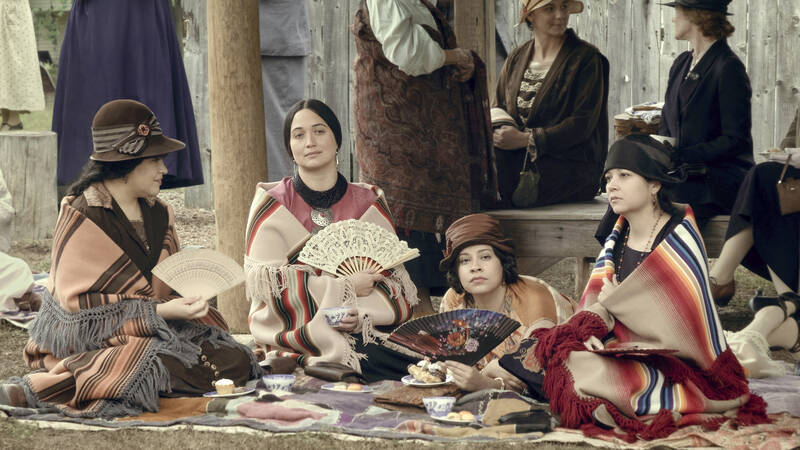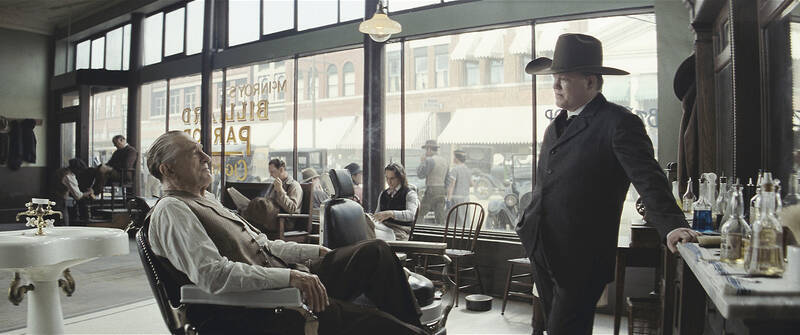As eagles swoop overhead and a cool autumnal wind blows through the cemetery in Gray Horse, on the ancient lands of the Osage people in northern Oklahoma, Margie Burkhart points to the tombs of ancestors murdered a century ago.
The tragedy that struck her family is at the heart of the new Martin Scorsese film Killers of the Flower Moon, taken from the best-selling book of the same name.
In the 1920s, Mollie Burkhart, Margie’s grandmother — played in the film by Native American actress Lily Gladstone — saw her mother, her sisters and her brother-in-law murdered.

Photos: AP
The killings came one after another — in a poisoning, in a bombing, by a bullet to the head.
“I think they systematically chose which ones to die,” 61-year-old Margie Burkhart said.
Intensifying the ordeal even further: The killings were orchestrated by Mollie’s own husband, Ernest Burkhart, played by Leonardo DiCaprio, and his uncle William Hale (Robert De Niro) — two white settlers intent on getting their hands on the Osage family’s rights to their oil-rich property.

Photos: AP
REIGN OF TERROR
Today, the yellowing fields around Gray Horse are dotted with the occasional oil rig — but this is nothing compared to the huge boom at the turn of the 20th century, when the huge machinery covered the prairies for miles around. That’s when one of the most prolific oil fields in the US at the time was discovered on the Osage reservation.
The Osage people held the exclusive rights to exploiting this underground wealth — rights that legally could only be transferred to or inherited by an Osage member’s legal heir.
“The Osages were considered the wealthiest people in the world,” said Kathryn Red Corn, who is Osage, speaking in a house built by her great-grandfather in Pawhuska, the seat of the Osage nation’s current government. That wealth drew the attention of some nefarious white settlers.
People came to the area and wooed and married members of the Osage nation for their money, the 82-year-old Red Corn said. “They would have them murdered, and then they would inherit what they had,” she said. The walls of her living room are decorated with Osage art and black-and-white photos of her ancestors.
In all, at least 60 members of the Osage nation — many more by some estimates — were believed murdered during a period that became known as the Reign of Terror.
SUSPICIOUS POISONING
Red Corn’s grandfather, Raymond Red Corn Sr., who was also Osage, suspected his second wife, a white woman, of poisoning him. He died suddenly in his 40s and in otherwise good health, Kathryn Red Corn said. His death, in the early 1920s, was never investigated.
For Margie Burkhart, the sense of anger and suffering around these murders are still palpable — feelings reawakened this summer when she attended a private screening of Scorsese’s film.
“They took away my (great-)aunties, and I could have had a big family,” she said, almost choking on the words. “I could have had a lot of cousins, nieces, nephews — and I grew up without them.”
She added: “William Hale didn’t have to do that,” she said of one of the masterminds of the killings. “He was one of the richest people in Osage County.”
“It was just for greed. He wanted more money.”
NO JUSTICE
“Simply because they were Indian, their life had lesser value,” lamented 62-year-old Jim Gray, a former principal chief of the Osage nation.
He said his great-grandfather Henry Roan was murdered in 1923, also in a plot organized by Hale, who had taken out a life insurance policy in Roan’s name. Both Ernest Burkhart and Hale were eventually convicted of murder — despite their efforts at a cover-up — and received life sentences.
Gray said only a small percentage of the Osage murders in this period were investigated by federal authorities.
“These stories have not been told,” he said in the small town of Skiatook, north of Tulsa. “There’s been no justice for those families.”
Gray was deeply concerned when he heard that Hollywood had taken an interest in this painful chapter of Osage history. “Were we just going to be second-tier characters in our own story?” he wondered.
Instead, Gray said, “Imagine our surprise when Scorsese reached out and met with us, and listened to us and effectively rewrote big portions of the script.”
Having originally focused on the federal investigation, writers reworked the script to center on the story of Mollie and Ernest Burkhart.
“You’re going to watch this film and the Osage influence, you’re going to be able to feel it,” Gray said. He hopes the film’s release tomorrow will spark debate about “the people that were stepped on” to make the country “what it is today.” Gray added: “People may not want to talk about it. It’s not in our history books.”
But, he went on, “We need to know our past, especially the mistakes ... so that we won’t repeat them.”
Margie Burkhart also hopes the film keeps memories of the Osage’s searing trauma from dimming into oblivion.
“In two, three years from now, when the movie fades away, I hope people are still talking about it,” she said.

The Democratic Progressive Party (DPP), Chinese Nationalist Party (KMT), and the country’s other political groups dare not offend religious groups, says Chen Lih-ming (陳立民), founder of the Taiwan Anti-Religion Alliance (台灣反宗教者聯盟). “It’s the same in other democracies, of course, but because political struggles in Taiwan are extraordinarily fierce, you’ll see candidates visiting several temples each day ahead of elections. That adds impetus to religion here,” says the retired college lecturer. In Japan’s most recent election, the Liberal Democratic Party lost many votes because of its ties to the Unification Church (“the Moonies”). Chen contrasts the progress made by anti-religion movements in

Taiwan doesn’t have a lot of railways, but its network has plenty of history. The government-owned entity that last year became the Taiwan Railway Corp (TRC) has been operating trains since 1891. During the 1895-1945 period of Japanese rule, the colonial government made huge investments in rail infrastructure. The northern port city of Keelung was connected to Kaohsiung in the south. New lines appeared in Pingtung, Yilan and the Hualien-Taitung region. Railway enthusiasts exploring Taiwan will find plenty to amuse themselves. Taipei will soon gain its second rail-themed museum. Elsewhere there’s a number of endearing branch lines and rolling-stock collections, some

Last week the State Department made several small changes to its Web information on Taiwan. First, it removed a statement saying that the US “does not support Taiwan independence.” The current statement now reads: “We oppose any unilateral changes to the status quo from either side. We expect cross-strait differences to be resolved by peaceful means, free from coercion, in a manner acceptable to the people on both sides of the Strait.” In 2022 the administration of Joe Biden also removed that verbiage, but after a month of pressure from the People’s Republic of China (PRC), reinstated it. The American

This was not supposed to be an election year. The local media is billing it as the “2025 great recall era” (2025大罷免時代) or the “2025 great recall wave” (2025大罷免潮), with many now just shortening it to “great recall.” As of this writing the number of campaigns that have submitted the requisite one percent of eligible voters signatures in legislative districts is 51 — 35 targeting Chinese Nationalist Party (KMT) caucus lawmakers and 16 targeting Democratic Progressive Party (DPP) lawmakers. The pan-green side has more as they started earlier. Many recall campaigns are billing themselves as “Winter Bluebirds” after the “Bluebird Action”